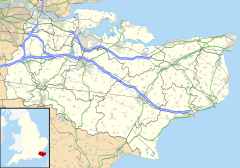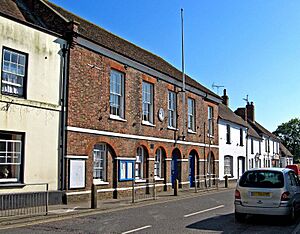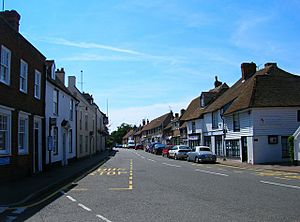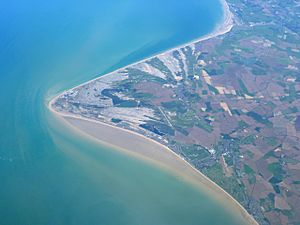Lydd facts for kids
Quick facts for kids Lydd |
|
|---|---|
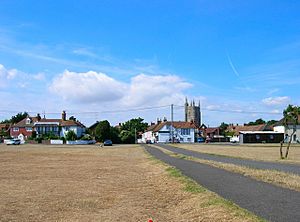 The Rype, Lydd |
|
| Population | 6,567 (2011) |
| District |
|
| Shire county | |
| Region | |
| Country | England |
| Sovereign state | United Kingdom |
| Post town | Romney Marsh |
| Postcode district | TN29 |
| Dialling code | 01797 |
| Police | Kent |
| Fire | Kent |
| Ambulance | South East Coast |
| EU Parliament | South East England |
| UK Parliament |
|
Lydd is a town in Kent, England. It is located on a flat, low-lying area called Romney Marsh. Lydd is one of the biggest towns on the marsh and the most southerly town in Kent.
In the 1200s, Lydd was very important. It was part of the Cinque Ports, a group of coastal towns that helped protect England. Lydd was like a "limb" or partner town to Romney.
The town of Lydd includes the main area, plus Dungeness, Lydd-on-Sea, and parts of Greatstone-on-Sea.
Some interesting old buildings in Lydd are the Gordon house longhall, a guildhall, and a medieval courthouse. Lydd is found southwest of New Romney and east of Rye.
Contents
Lydd's Past: A Quick Look
The name 'Lydd' comes from an old English word, hlid, which means 'slope'. It was first written down in the year 774.
Lydd started as a village on a shingle (small stones) island during the Roman times. Back then, the sea cut Lydd off from the rest of the land.
The town kept growing into the Saxon period. The Saxon church even used materials from Roman buildings. Lydd was most successful in the 1200s when it joined the Cinque Ports.
In the 1700s and 1800s, Lydd was a place where smuggling happened. The Lydd Guildhall, built in 1792, even had prison cells.
Before and during the First World War, Lydd Camp was a key place for army training. In 1888, experiments with explosives near Lydd led to the invention of Lyddite. Lydd was once a town with many soldiers. It also had a large narrow-gauge railway. The area is still used for military training today.
Lydd During World War II

In September 1940, four young Dutch men arrived on the coast near Lydd in a rowing boat. One was arrested for spying.
On October 21, a German Dornier Do 17 plane had to land at RAF Lydd. The pilot was lost because new British equipment was confusing his navigation signals. This Dornier was the first of its kind to be captured by British spies.
On June 26, a Vickers Wellington bomber crashed near Lydd after a big attack on Bremen. The 19-year-old pilot landed the plane safely, and the crew survived.
On November 27, 1942, a train leaving Lydd Town railway station was attacked by two German planes. The engine was hit, and steam shot out, causing one German plane to crash. No one on the train was hurt.
All Saints' Church: The Cathedral on the Marsh
All Saints' Church is also known as Lydd Church or "The Cathedral on the Marsh." It is the longest parish church in Kent, measuring 199 feet (about 60 meters). Its tower is also very tall, at 132 feet (about 40 meters).
People think the church might include parts of a small Roman building from the 400s. Most of the church you see today was built in the Middle Ages.
In the 1400s, the church was linked to local groups and could hold 1,000 people. It was badly damaged during World War II but was later fixed. In 1950, it became a Grade I listed building, meaning it's very important.
The tall tower of Lydd church was used in a big survey between 1784 and 1790. This survey connected the Royal Greenwich Observatory in England with the Paris Observatory in France. It helped measure the distance between the two countries very accurately.
What Lydd Does: Economy
The Lydd area has four important electricity sites. These include the Dungeness A & B Nuclear Power Stations. Dungeness A has stopped making electricity and is being taken apart.
There is also a large substation for the National Grid. This helps send electricity around the country.
Sports and Fun in Lydd
Lydd has two football clubs: Lydd Town, started in 1885, and Lydd United, started in 2009. Lydd Town plays in the Kent Invicta Football League.
You can also find a kart and minimoto track called Lydd International Kart Circuit. Lydd Cricket Club plays at the Banks, Dennes Lane.
Lydd Golf Club and Driving Range is on Romney Road. It has an 18-hole golf course, a driving range, and practice areas.
Local News and Radio
Lydd has local newspapers like the Romney Marsh Herald and the Kentish Express. There are also free local papers like the Folkestone and Hythe Extra.
For radio, Lydd gets KMFM Shepway and White Cliffs Country. You can also listen to county-wide stations like Heart and BBC Radio Kent.
Cinque Ports Radio 100.2FM is a community radio station for Romney Marsh and Rye. It started broadcasting in March 2022.
Lydd Club Day: A Big Party!
Lydd Club Day is a yearly carnival held on the Rype. It's the biggest festival on Romney Marsh and happens on the third Saturday of June.
It started in 1868 and has happened every year since, except during wars. The day includes a funfair, a morning boot fair (like a car boot sale), stalls, and children dressing up. In the evening, there's a parade with floats and fireworks. The day ends with the crowning of the Queen Elect.
The night before Club Day, on Friday, is "Test Night." The funfair opens with cheaper prices.
"Pirate Friday" also started in the early 2000s. On this night, many people in Lydd dress up as pirates and visit the local pubs. It's become a very popular yearly event.
Trains and Travel
A railway line used to run from Dungeness to Appledore. It had stations at Lydd Town and Lydd-on-Sea.
This line carried passengers from 1881 to 1967. It is still used for freight (carrying goods). There have been talks about reopening the line for passengers.
The Romney, Hythe and Dymchurch Railway is a smaller, narrow-gauge railway. It has two stations in the Lydd area: Romney Sands and Dungeness.
Lydd Airport
Lydd Airport, also known as London Ashford Airport, was the first airport built in Britain after the Second World War. It was originally called Ferryfield.
Famous People from Lydd
- David Denne (1799–1861): He was a first-class cricketer and a local leader. He was also a Justice of the Peace and a captain in the army.
- Samuel Fisher (1605–1665): He was a well-known speaker in Lydd. He later became a Baptist and a Quaker. He was known for his strong religious views. He lived in Lydd from 1632 to 1660.
Lydd's Weather
The weather in Lydd is generally mild. It doesn't get too hot or too cold, and there's a good amount of rain all year. This type of weather is called an "Oceanic climate."
| Climate data for Lydd Airport weather station, 16m amsl (ICAO code: EGMD, WMO identifier: 03887) | |||||||||||||
|---|---|---|---|---|---|---|---|---|---|---|---|---|---|
| Month | Jan | Feb | Mar | Apr | May | Jun | Jul | Aug | Sep | Oct | Nov | Dec | Year |
| Mean daily maximum °C (°F) | 7 (45) |
7 (45) |
9 (48) |
11 (52) |
14 (58) |
17 (63) |
19 (67) |
20 (68) |
18 (65) |
14 (58) |
10 (50) |
8 (46) |
13 (55) |
| Mean daily minimum °C (°F) | 3 (38) |
3 (37) |
3 (37) |
5 (41) |
8 (46) |
11 (51) |
13 (56) |
13 (56) |
12 (53) |
8 (47) |
5 (41) |
3 (38) |
7 (45) |
| Average precipitation mm (inches) | 48 (1.9) |
41 (1.6) |
46 (1.8) |
36 (1.4) |
33 (1.3) |
41 (1.6) |
46 (1.8) |
51 (2) |
53 (2.1) |
89 (3.5) |
71 (2.8) |
71 (2.8) |
620 (24.6) |
| Average relative humidity (%) | 86 | 84 | 79 | 75 | 76 | 75 | 74 | 75 | 77 | 82 | 86 | 86 | 80 |
| Average dew point °C (°F) | 4 (39) |
4 (39) |
5 (41) |
7 (45) |
9 (48) |
12 (54) |
14 (57) |
14 (57) |
13 (55) |
11 (52) |
8 (46) |
5 (41) |
9 (48) |
| Source 1: Weatherbase | |||||||||||||
| Source 2: Time and Date (dewpoints and humidity, between 2005−2015) | |||||||||||||
See also
 In Spanish: Lydd para niños
In Spanish: Lydd para niños


